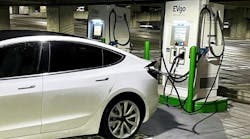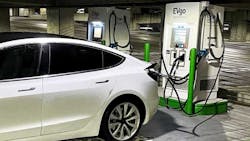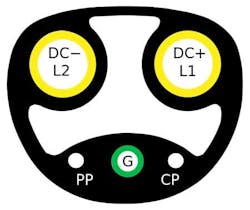EV-Pluribus Unum: An Introduction to the SAE J3400/NACS EV Charging Interface (Part 1)
Members can download this article in PDF format.
What you’ll learn:
- How the SAE-J3400 EV charging standard works, and how it differs from the Tesla NACS interface it's based on.
- How does the connector's unique interface enable it to support both AC and DC charging on the same pair of contacts?
- Some of the challenges designers and manufacturers will face during the transition to this new standard.
For Part 2, click here.
As electrified vehicle sales continue to grow, the technology that supports them, and the standards that govern them, continue to evolve at a brisk pace. Even as late as July 2023, when I published an article about the SAE AE J1772 standard, and its dc-capable variant, the Combined Charging System (CCS) charging interface,1 it looked like the North American EV industry would be struggling with a fleet divided between its nominal standard and Tesla's proprietary North American Charging Standard (NACS) for at least several more years (Fig. 1).
However, shortly after that article was published, the forces of natural selection took over. It’s now far easier to list the handful of companies who will still use CCS than enumerate the vast number of manufacturers who will be rocking NACS ports on their EVs' flanks by 2025.2 This article presents an overview of the NACS interface, its journey toward becoming a formal standard, and a look at some of the issues involved in its adoption.
The Transition from CCS to NACS: A Rapid Shift in EV Charging Standards
The origins of the shift from CCS to NACS can be traced back to the fall of 2022, when Tesla opened its then-proprietary standard to make the specification available to other EV manufacturers. NACS's sleeker, more compact form factor, and its ability to support charge currents of up to 1000 A, were compelling. The driving force behind its widespread adoption may have been the potential for other manufacturers’ cars to gain access to Tesla's extensive, and rapidly expanding, national network of NACS-compatible charging stations.
As of this writing, Energy Your Way reports that Tesla currently has over 19,800 charging stations and over 73,000 individual charging points across the U.S., with over 12,800 of those in California alone. This includes over 1,000 Supercharger-equipped locations, with roughly 17,000 individual Superchargers.
Driven by this combination of market and technical realities, SAE International announced that it had created a task force to turn Tesla's specification into a formal standard in June of 2023. In an uncharacteristically short period of time it released the SAE J3400 EV Coupler Standard, on December 18, 2023.3 (Note: After the release of the formal standard, Tesla removed the documentation for the NACS interface from its website, but it’s still available at the time of this writing by using a Chrome browser to access this link.)
Understanding the Shared Pin System in NACS and SAE J3400
Both the NACS and the SAE J3400 EV Coupler standards are based on a compact 5-pin form factor (Fig. 2). One of its unique features is that, unlike most previous EV charging systems, it uses the same two primary pins for both AC charging and DC fast charging.
This so-called Shared Pin system uses a combination of hardware interlocks and redundant firmware logic. Thus, it ensures that only one charging mode can be engaged at a time and that both sides are protected against overcurrent, overtemperature, and ground fault conditions.4,5
As illustrated in Figure 2, the connector pins' functions are as follows:
- DC+/L1: During DC charging, it serves as the positive side of the DC voltage feed. In AC charging mode, it serves as either Line 1 in a split-phase connection or the sole line in a single-phase connection.
- DC−/L2: During DC charging, it serves as the negative side of the DC voltage feed. In AC charging mode, it serves as either Line 2 in a split-phase connection or the neutral in a single-phase connection.
- Ground (G): This pin provides a connection between the earth and the vehicle chassis. In addition, the ground pin is used as a reference point for the CP and PP signals as well as to measure the isolation of the electrical systems.3
- Control Pilot (CP): This pin is a channel for digital communication between the charging system and vehicle. Just like the earlier SAE AE J1772/CCS standards, the NACS control pilot uses a power-line communication (PLC) scheme defined in the IEC 618516 standard to communicate charging state and current. During DC charging, a pulse-width-modulated signal is transmitted across the control pilot line.
- Proximity Pilot (PP): This pin carries a low-voltage signal that’s used to sense the status of the vehicle connector. When the button on the charger's mating plug is depressed to unlock the connector from the EV, a switch on the Proximity Pilot circuit is opened that disables any further power delivery.
For DC charging, communication between the EV and its charging device is accomplished via power-line communication over the control pilot line as defined by the DIN 70121 spec. The North American Charging Standard is compatible with “plug and charge” V2G communication protocol as defined in ISO-15118.3
Pin usage is the same as the SAE J1772 connector when employed for AC charging.3
NACS/SAE J3400 Interface: Safety and Communication Protocols
Since the NACS/SAE J3400 interface uses the same power pins for both AC and DC charging operations, the specification includes a series of interlocks and safety protocols to ensure that only one power-delivery path can be active at a given time. Both the SAE J3400 connector and the latest version of the Tesla charging interface are referred to as NACS (2021 and beyond) support vehicle-charger communications using the dual-mode PLC protocol defined in the IEC 61851 standard.6
The first mode, known as Basic Signaling (BS), is the same PWM scheme transmitted over the CP contact used by J1772 ac charging systems for safety-related functions and, in the case of ac charging, to advertise the power level the available from the charging station. The station can also transmit a pulse width of 5%, which indicates the High Level Communication (HLC) protocol should be used.
The HLC protocol involves transmitting a modulated high-frequency signal over the CP contact (also known as power-line communication or PLC) based on the standard DIN SPEC 70121 and the ISO/IEC 15118 standard.8 It can be used to transmit digital commands and information.
Stay Tuned for Part 2
The Shared Pin arrangement used by the NACS/SAE J3400 interface offers a more compact, unified connector that should eventually result in a unified charging infrastructure throughout North America (Fig. 3). It does, however, require EVs to include the hardware and software necessary to preclude the possibility of any interaction between the AC and DC charging system elements.
In Part 2 of this series, we’ll take a close look at these parts of the specification. It also goes into some of the issues that will require attention on the part of manufacturers and design engineers during the transition to a unified charging standard.
References
1. Lee Goldberg, "An Introduction to the SAE J1772 and CCS EV Charging Interfaces", Electronic Design, July 2023.
2. Jessica Shea Choksey, “What is the North American Charging Standard (NACS)?,” J.D. Power, Oct 20, 2023.
3. “NACS Electric Vehicle Coupler J3400_202312 Standard” and “North American Charging Standard.”
4. Tesla, "North American Charging Standard - Charging & Adapter Product Guides.”
5. Tesla, "Pin Sharing Index - North American Charging Standard - Charging & Adapter Product Guides."
6. IEC 1685, Wikipedia.
7. Tesla, "North American Charging Standard TS-0023666,” 2022 .
8. “ISO 15118-1:2019: Road vehicles — Vehicle to grid communication interface,” International Standards Organization (ISO).




